Measuring Performance and Control Measures in Apple Inc.
VerifiedAdded on 2019/11/29
|12
|3148
|25
Report
AI Summary
The provided content is about the company Apple Inc., highlighting its positive outlook due to significant investments in research and development, aggressive sales and marketing strategies, and continued global expansion. The company's success can be attributed to its strong leadership, innovative products, and ability to adapt to changing market trends.
Contribute Materials
Your contribution can guide someone’s learning journey. Share your
documents today.
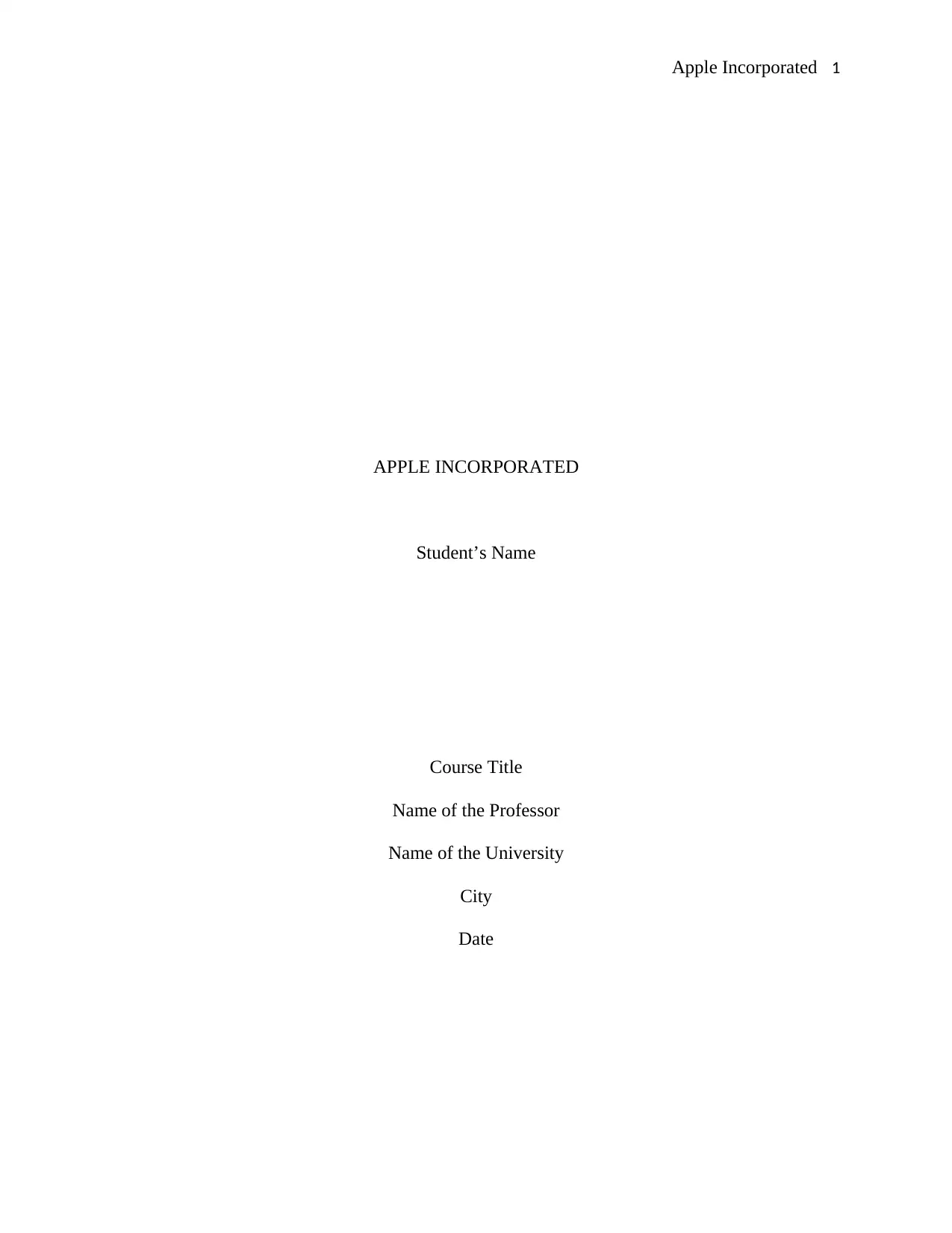
Apple Incorporated 1
APPLE INCORPORATED
Student’s Name
Course Title
Name of the Professor
Name of the University
City
Date
APPLE INCORPORATED
Student’s Name
Course Title
Name of the Professor
Name of the University
City
Date
Secure Best Marks with AI Grader
Need help grading? Try our AI Grader for instant feedback on your assignments.
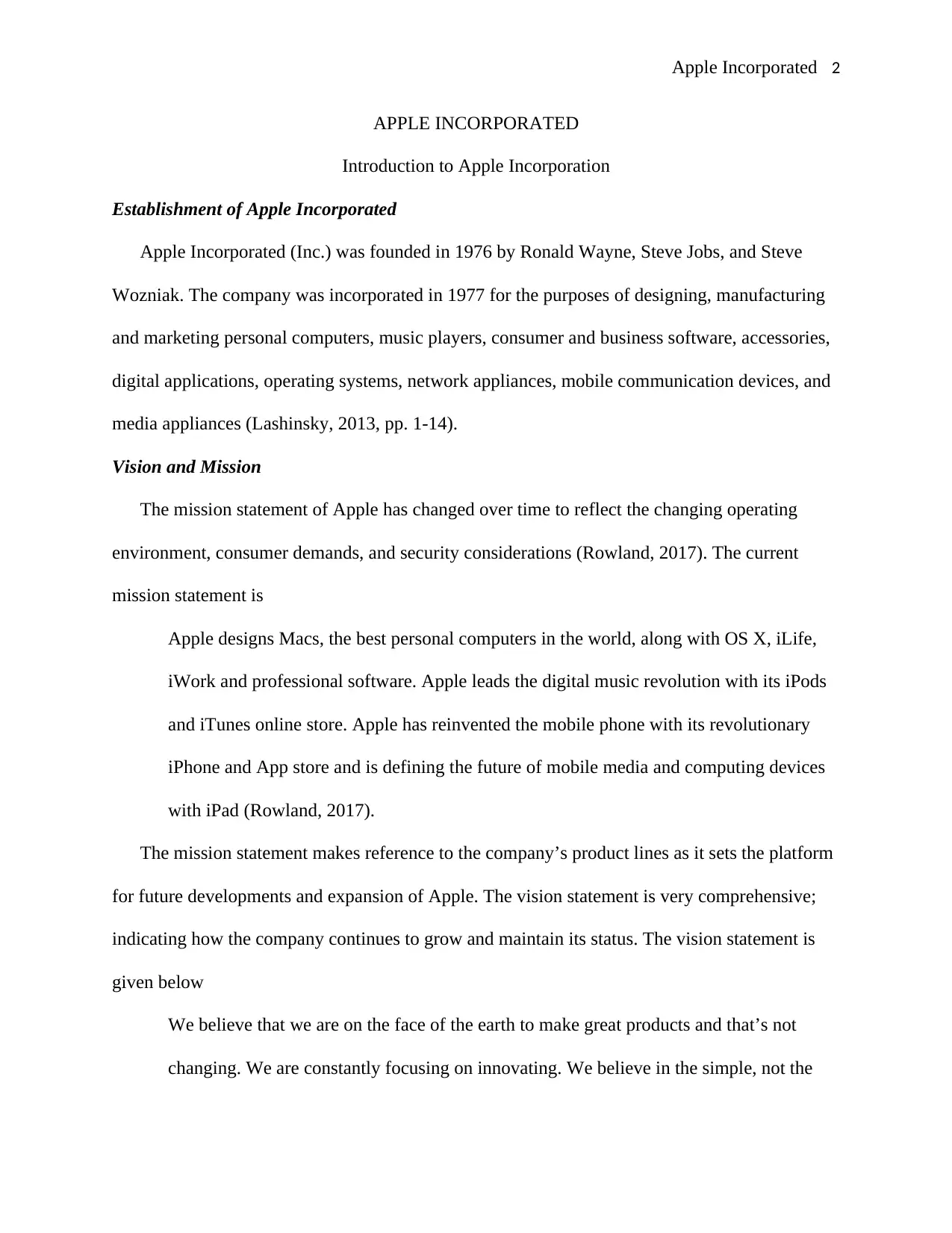
Apple Incorporated 2
APPLE INCORPORATED
Introduction to Apple Incorporation
Establishment of Apple Incorporated
Apple Incorporated (Inc.) was founded in 1976 by Ronald Wayne, Steve Jobs, and Steve
Wozniak. The company was incorporated in 1977 for the purposes of designing, manufacturing
and marketing personal computers, music players, consumer and business software, accessories,
digital applications, operating systems, network appliances, mobile communication devices, and
media appliances (Lashinsky, 2013, pp. 1-14).
Vision and Mission
The mission statement of Apple has changed over time to reflect the changing operating
environment, consumer demands, and security considerations (Rowland, 2017). The current
mission statement is
Apple designs Macs, the best personal computers in the world, along with OS X, iLife,
iWork and professional software. Apple leads the digital music revolution with its iPods
and iTunes online store. Apple has reinvented the mobile phone with its revolutionary
iPhone and App store and is defining the future of mobile media and computing devices
with iPad (Rowland, 2017).
The mission statement makes reference to the company’s product lines as it sets the platform
for future developments and expansion of Apple. The vision statement is very comprehensive;
indicating how the company continues to grow and maintain its status. The vision statement is
given below
We believe that we are on the face of the earth to make great products and that’s not
changing. We are constantly focusing on innovating. We believe in the simple, not the
APPLE INCORPORATED
Introduction to Apple Incorporation
Establishment of Apple Incorporated
Apple Incorporated (Inc.) was founded in 1976 by Ronald Wayne, Steve Jobs, and Steve
Wozniak. The company was incorporated in 1977 for the purposes of designing, manufacturing
and marketing personal computers, music players, consumer and business software, accessories,
digital applications, operating systems, network appliances, mobile communication devices, and
media appliances (Lashinsky, 2013, pp. 1-14).
Vision and Mission
The mission statement of Apple has changed over time to reflect the changing operating
environment, consumer demands, and security considerations (Rowland, 2017). The current
mission statement is
Apple designs Macs, the best personal computers in the world, along with OS X, iLife,
iWork and professional software. Apple leads the digital music revolution with its iPods
and iTunes online store. Apple has reinvented the mobile phone with its revolutionary
iPhone and App store and is defining the future of mobile media and computing devices
with iPad (Rowland, 2017).
The mission statement makes reference to the company’s product lines as it sets the platform
for future developments and expansion of Apple. The vision statement is very comprehensive;
indicating how the company continues to grow and maintain its status. The vision statement is
given below
We believe that we are on the face of the earth to make great products and that’s not
changing. We are constantly focusing on innovating. We believe in the simple, not the
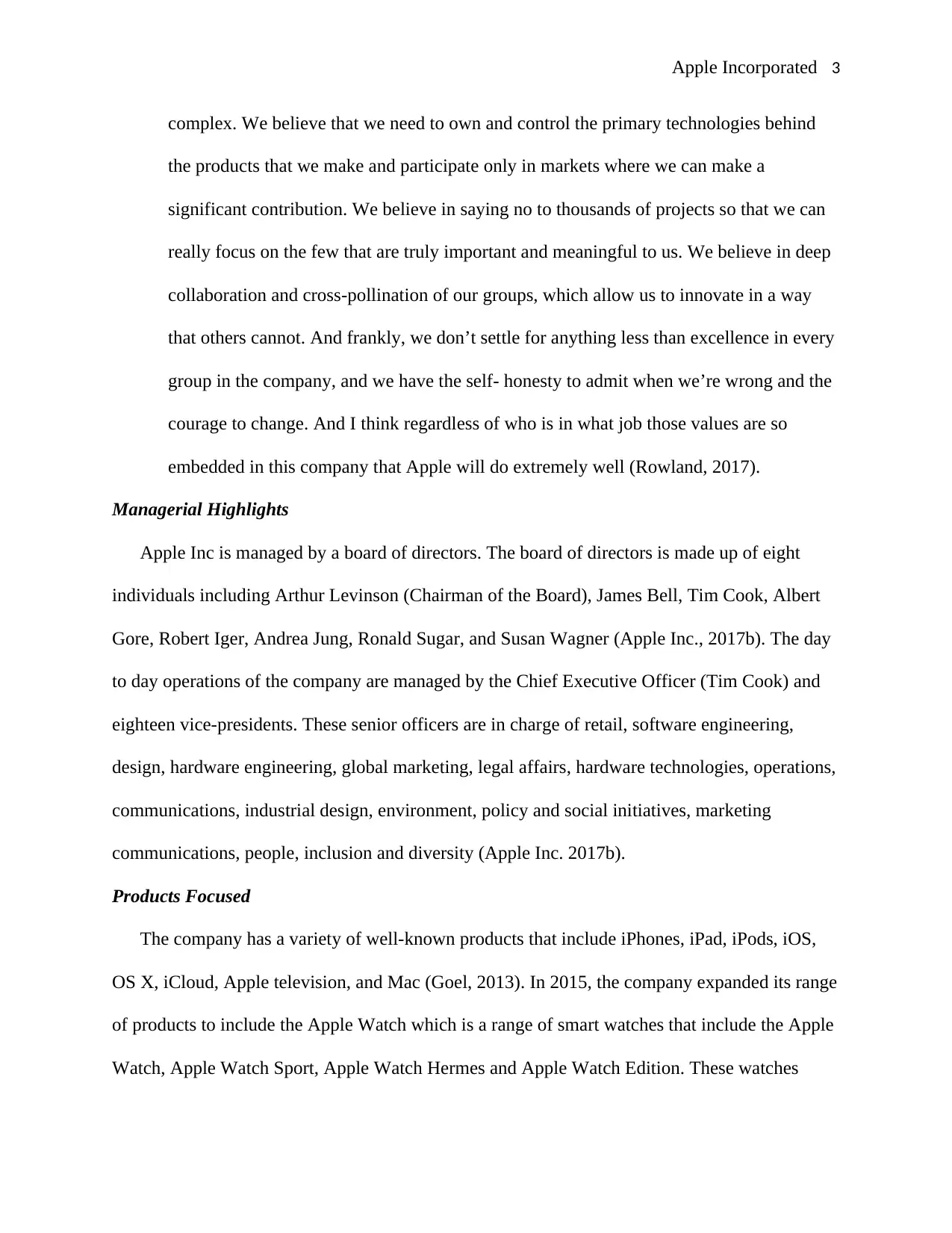
Apple Incorporated 3
complex. We believe that we need to own and control the primary technologies behind
the products that we make and participate only in markets where we can make a
significant contribution. We believe in saying no to thousands of projects so that we can
really focus on the few that are truly important and meaningful to us. We believe in deep
collaboration and cross-pollination of our groups, which allow us to innovate in a way
that others cannot. And frankly, we don’t settle for anything less than excellence in every
group in the company, and we have the self- honesty to admit when we’re wrong and the
courage to change. And I think regardless of who is in what job those values are so
embedded in this company that Apple will do extremely well (Rowland, 2017).
Managerial Highlights
Apple Inc is managed by a board of directors. The board of directors is made up of eight
individuals including Arthur Levinson (Chairman of the Board), James Bell, Tim Cook, Albert
Gore, Robert Iger, Andrea Jung, Ronald Sugar, and Susan Wagner (Apple Inc., 2017b). The day
to day operations of the company are managed by the Chief Executive Officer (Tim Cook) and
eighteen vice-presidents. These senior officers are in charge of retail, software engineering,
design, hardware engineering, global marketing, legal affairs, hardware technologies, operations,
communications, industrial design, environment, policy and social initiatives, marketing
communications, people, inclusion and diversity (Apple Inc. 2017b).
Products Focused
The company has a variety of well-known products that include iPhones, iPad, iPods, iOS,
OS X, iCloud, Apple television, and Mac (Goel, 2013). In 2015, the company expanded its range
of products to include the Apple Watch which is a range of smart watches that include the Apple
Watch, Apple Watch Sport, Apple Watch Hermes and Apple Watch Edition. These watches
complex. We believe that we need to own and control the primary technologies behind
the products that we make and participate only in markets where we can make a
significant contribution. We believe in saying no to thousands of projects so that we can
really focus on the few that are truly important and meaningful to us. We believe in deep
collaboration and cross-pollination of our groups, which allow us to innovate in a way
that others cannot. And frankly, we don’t settle for anything less than excellence in every
group in the company, and we have the self- honesty to admit when we’re wrong and the
courage to change. And I think regardless of who is in what job those values are so
embedded in this company that Apple will do extremely well (Rowland, 2017).
Managerial Highlights
Apple Inc is managed by a board of directors. The board of directors is made up of eight
individuals including Arthur Levinson (Chairman of the Board), James Bell, Tim Cook, Albert
Gore, Robert Iger, Andrea Jung, Ronald Sugar, and Susan Wagner (Apple Inc., 2017b). The day
to day operations of the company are managed by the Chief Executive Officer (Tim Cook) and
eighteen vice-presidents. These senior officers are in charge of retail, software engineering,
design, hardware engineering, global marketing, legal affairs, hardware technologies, operations,
communications, industrial design, environment, policy and social initiatives, marketing
communications, people, inclusion and diversity (Apple Inc. 2017b).
Products Focused
The company has a variety of well-known products that include iPhones, iPad, iPods, iOS,
OS X, iCloud, Apple television, and Mac (Goel, 2013). In 2015, the company expanded its range
of products to include the Apple Watch which is a range of smart watches that include the Apple
Watch, Apple Watch Sport, Apple Watch Hermes and Apple Watch Edition. These watches
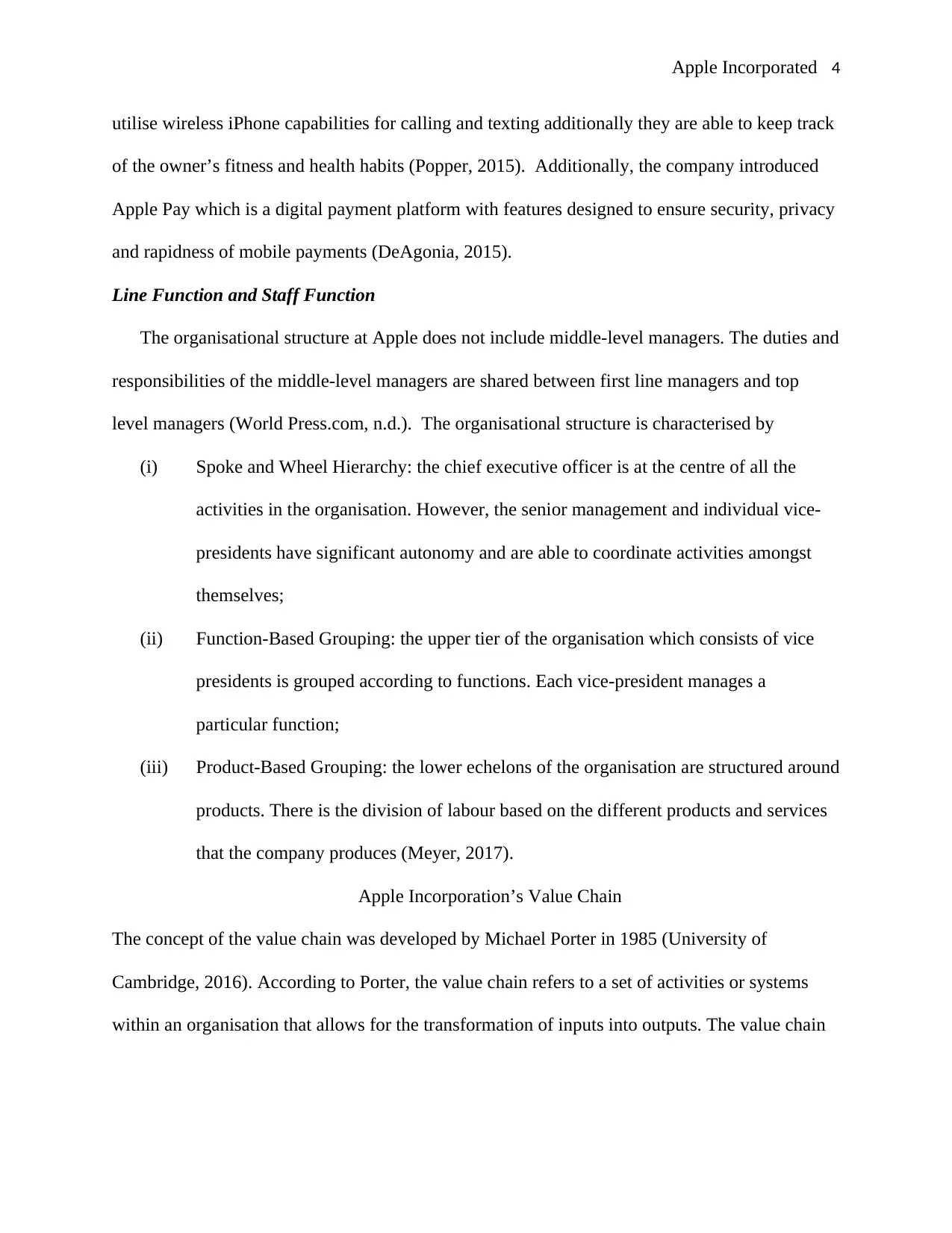
Apple Incorporated 4
utilise wireless iPhone capabilities for calling and texting additionally they are able to keep track
of the owner’s fitness and health habits (Popper, 2015). Additionally, the company introduced
Apple Pay which is a digital payment platform with features designed to ensure security, privacy
and rapidness of mobile payments (DeAgonia, 2015).
Line Function and Staff Function
The organisational structure at Apple does not include middle-level managers. The duties and
responsibilities of the middle-level managers are shared between first line managers and top
level managers (World Press.com, n.d.). The organisational structure is characterised by
(i) Spoke and Wheel Hierarchy: the chief executive officer is at the centre of all the
activities in the organisation. However, the senior management and individual vice-
presidents have significant autonomy and are able to coordinate activities amongst
themselves;
(ii) Function-Based Grouping: the upper tier of the organisation which consists of vice
presidents is grouped according to functions. Each vice-president manages a
particular function;
(iii) Product-Based Grouping: the lower echelons of the organisation are structured around
products. There is the division of labour based on the different products and services
that the company produces (Meyer, 2017).
Apple Incorporation’s Value Chain
The concept of the value chain was developed by Michael Porter in 1985 (University of
Cambridge, 2016). According to Porter, the value chain refers to a set of activities or systems
within an organisation that allows for the transformation of inputs into outputs. The value chain
utilise wireless iPhone capabilities for calling and texting additionally they are able to keep track
of the owner’s fitness and health habits (Popper, 2015). Additionally, the company introduced
Apple Pay which is a digital payment platform with features designed to ensure security, privacy
and rapidness of mobile payments (DeAgonia, 2015).
Line Function and Staff Function
The organisational structure at Apple does not include middle-level managers. The duties and
responsibilities of the middle-level managers are shared between first line managers and top
level managers (World Press.com, n.d.). The organisational structure is characterised by
(i) Spoke and Wheel Hierarchy: the chief executive officer is at the centre of all the
activities in the organisation. However, the senior management and individual vice-
presidents have significant autonomy and are able to coordinate activities amongst
themselves;
(ii) Function-Based Grouping: the upper tier of the organisation which consists of vice
presidents is grouped according to functions. Each vice-president manages a
particular function;
(iii) Product-Based Grouping: the lower echelons of the organisation are structured around
products. There is the division of labour based on the different products and services
that the company produces (Meyer, 2017).
Apple Incorporation’s Value Chain
The concept of the value chain was developed by Michael Porter in 1985 (University of
Cambridge, 2016). According to Porter, the value chain refers to a set of activities or systems
within an organisation that allows for the transformation of inputs into outputs. The value chain
Secure Best Marks with AI Grader
Need help grading? Try our AI Grader for instant feedback on your assignments.
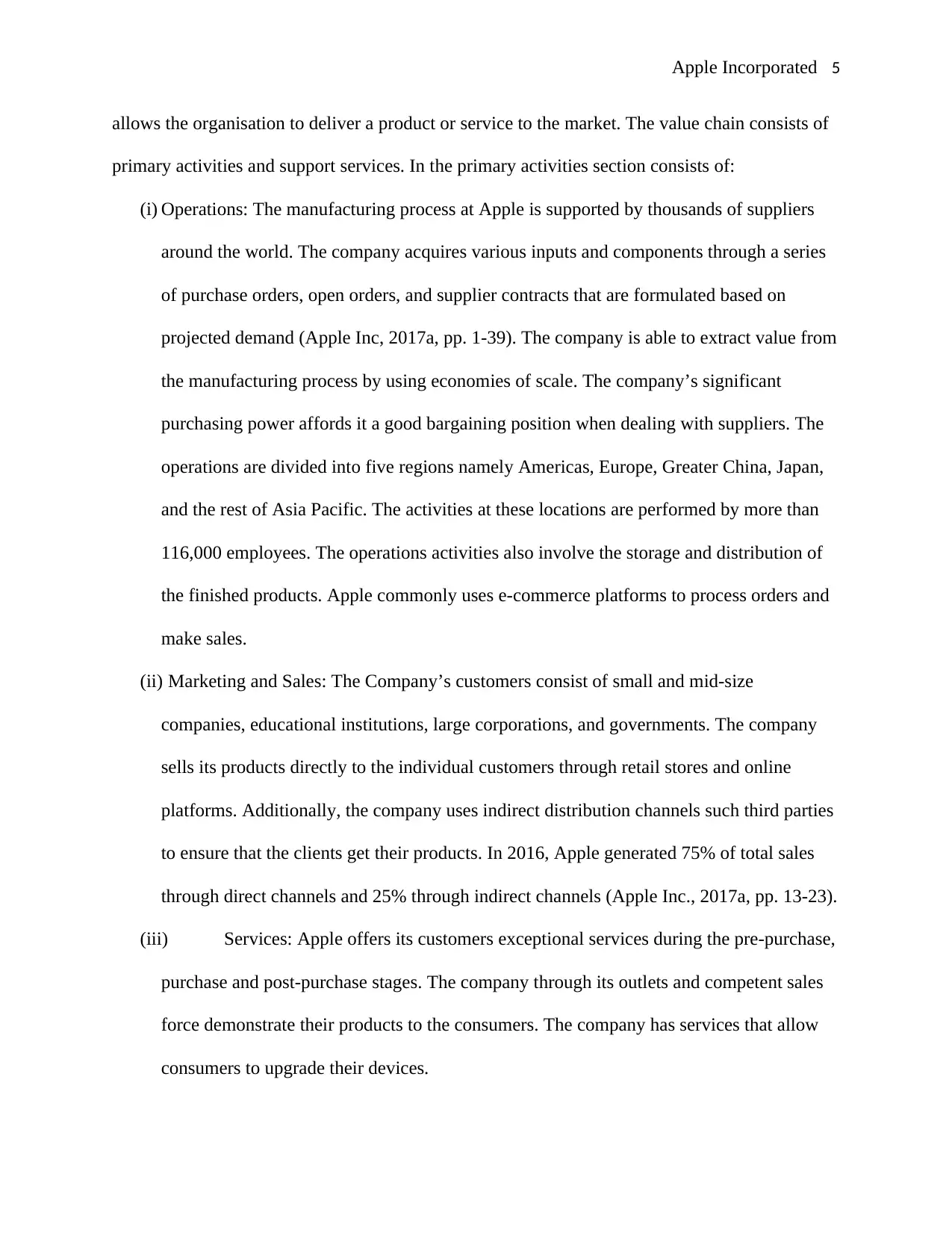
Apple Incorporated 5
allows the organisation to deliver a product or service to the market. The value chain consists of
primary activities and support services. In the primary activities section consists of:
(i) Operations: The manufacturing process at Apple is supported by thousands of suppliers
around the world. The company acquires various inputs and components through a series
of purchase orders, open orders, and supplier contracts that are formulated based on
projected demand (Apple Inc, 2017a, pp. 1-39). The company is able to extract value from
the manufacturing process by using economies of scale. The company’s significant
purchasing power affords it a good bargaining position when dealing with suppliers. The
operations are divided into five regions namely Americas, Europe, Greater China, Japan,
and the rest of Asia Pacific. The activities at these locations are performed by more than
116,000 employees. The operations activities also involve the storage and distribution of
the finished products. Apple commonly uses e-commerce platforms to process orders and
make sales.
(ii) Marketing and Sales: The Company’s customers consist of small and mid-size
companies, educational institutions, large corporations, and governments. The company
sells its products directly to the individual customers through retail stores and online
platforms. Additionally, the company uses indirect distribution channels such third parties
to ensure that the clients get their products. In 2016, Apple generated 75% of total sales
through direct channels and 25% through indirect channels (Apple Inc., 2017a, pp. 13-23).
(iii) Services: Apple offers its customers exceptional services during the pre-purchase,
purchase and post-purchase stages. The company through its outlets and competent sales
force demonstrate their products to the consumers. The company has services that allow
consumers to upgrade their devices.
allows the organisation to deliver a product or service to the market. The value chain consists of
primary activities and support services. In the primary activities section consists of:
(i) Operations: The manufacturing process at Apple is supported by thousands of suppliers
around the world. The company acquires various inputs and components through a series
of purchase orders, open orders, and supplier contracts that are formulated based on
projected demand (Apple Inc, 2017a, pp. 1-39). The company is able to extract value from
the manufacturing process by using economies of scale. The company’s significant
purchasing power affords it a good bargaining position when dealing with suppliers. The
operations are divided into five regions namely Americas, Europe, Greater China, Japan,
and the rest of Asia Pacific. The activities at these locations are performed by more than
116,000 employees. The operations activities also involve the storage and distribution of
the finished products. Apple commonly uses e-commerce platforms to process orders and
make sales.
(ii) Marketing and Sales: The Company’s customers consist of small and mid-size
companies, educational institutions, large corporations, and governments. The company
sells its products directly to the individual customers through retail stores and online
platforms. Additionally, the company uses indirect distribution channels such third parties
to ensure that the clients get their products. In 2016, Apple generated 75% of total sales
through direct channels and 25% through indirect channels (Apple Inc., 2017a, pp. 13-23).
(iii) Services: Apple offers its customers exceptional services during the pre-purchase,
purchase and post-purchase stages. The company through its outlets and competent sales
force demonstrate their products to the consumers. The company has services that allow
consumers to upgrade their devices.

Apple Incorporated 6
The support services of the value chain include:
(i) Development of Technologies: During the period 2014, 2015, and 2016, Apple spent $
6.0 billion, $ 8.1 billion, and 10.0 billion respectively on research and development
(Apple Inc., 2017a, p. 6). At the research and development stage, the company makes
improvements to the existing range of products and develops new products.
(ii) Human Resources: The human resource department is responsible for the recruitments,
retention, motivation, training, and development of the talented staff at Apple.
(iii) General Administration: The management of the company is responsible for the
success of the organisation. The general administration involves preparation of financial
statements, obtaining plants and facilities, managing the company’s image, handling
government and regulatory issues amongst others
The Process of Planning at Apple
Business Strategy
According to Apple Inc (2017a, p. 1), the company’s competitive strategy consists of three
elements
(i) Giving consumers the best user experience. This is achieved by having innovative
hardware, software and services (Apple Inc, 2017a, p. 1). Apple designs and
produces its own hardware, software, operating systems, services, applications, and
devices. All the components are integrated in a manner that makes them easy to use.
The company continually innovates in order to ensure that its products are the best.
(ii) Development of platforms that allow for a wide variety of content and applications
(apps). This makes it possible for different developers to sell their products and
services and allows the consumers access to a wider variety of products and services
The support services of the value chain include:
(i) Development of Technologies: During the period 2014, 2015, and 2016, Apple spent $
6.0 billion, $ 8.1 billion, and 10.0 billion respectively on research and development
(Apple Inc., 2017a, p. 6). At the research and development stage, the company makes
improvements to the existing range of products and develops new products.
(ii) Human Resources: The human resource department is responsible for the recruitments,
retention, motivation, training, and development of the talented staff at Apple.
(iii) General Administration: The management of the company is responsible for the
success of the organisation. The general administration involves preparation of financial
statements, obtaining plants and facilities, managing the company’s image, handling
government and regulatory issues amongst others
The Process of Planning at Apple
Business Strategy
According to Apple Inc (2017a, p. 1), the company’s competitive strategy consists of three
elements
(i) Giving consumers the best user experience. This is achieved by having innovative
hardware, software and services (Apple Inc, 2017a, p. 1). Apple designs and
produces its own hardware, software, operating systems, services, applications, and
devices. All the components are integrated in a manner that makes them easy to use.
The company continually innovates in order to ensure that its products are the best.
(ii) Development of platforms that allow for a wide variety of content and applications
(apps). This makes it possible for different developers to sell their products and
services and allows the consumers access to a wider variety of products and services
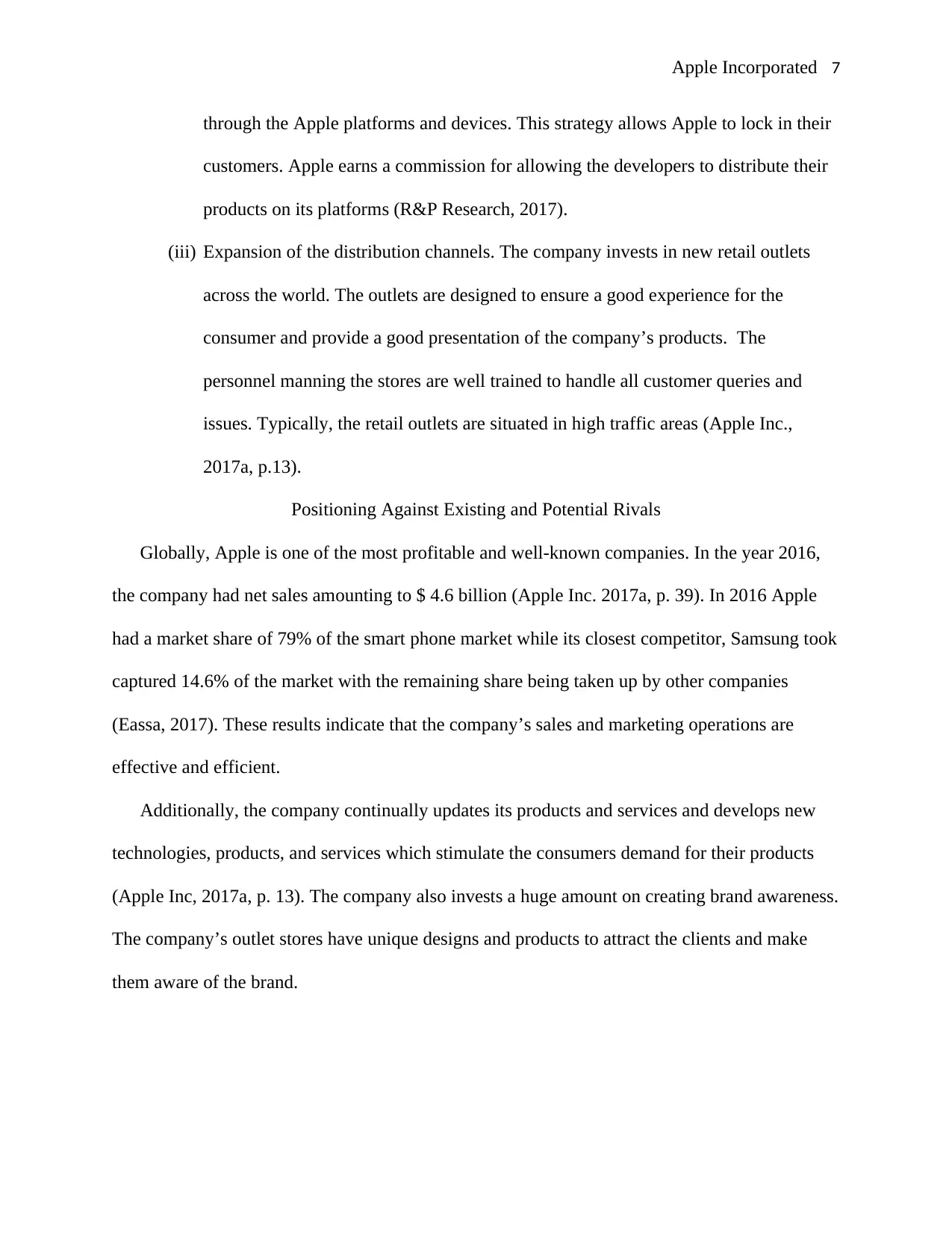
Apple Incorporated 7
through the Apple platforms and devices. This strategy allows Apple to lock in their
customers. Apple earns a commission for allowing the developers to distribute their
products on its platforms (R&P Research, 2017).
(iii) Expansion of the distribution channels. The company invests in new retail outlets
across the world. The outlets are designed to ensure a good experience for the
consumer and provide a good presentation of the company’s products. The
personnel manning the stores are well trained to handle all customer queries and
issues. Typically, the retail outlets are situated in high traffic areas (Apple Inc.,
2017a, p.13).
Positioning Against Existing and Potential Rivals
Globally, Apple is one of the most profitable and well-known companies. In the year 2016,
the company had net sales amounting to $ 4.6 billion (Apple Inc. 2017a, p. 39). In 2016 Apple
had a market share of 79% of the smart phone market while its closest competitor, Samsung took
captured 14.6% of the market with the remaining share being taken up by other companies
(Eassa, 2017). These results indicate that the company’s sales and marketing operations are
effective and efficient.
Additionally, the company continually updates its products and services and develops new
technologies, products, and services which stimulate the consumers demand for their products
(Apple Inc, 2017a, p. 13). The company also invests a huge amount on creating brand awareness.
The company’s outlet stores have unique designs and products to attract the clients and make
them aware of the brand.
through the Apple platforms and devices. This strategy allows Apple to lock in their
customers. Apple earns a commission for allowing the developers to distribute their
products on its platforms (R&P Research, 2017).
(iii) Expansion of the distribution channels. The company invests in new retail outlets
across the world. The outlets are designed to ensure a good experience for the
consumer and provide a good presentation of the company’s products. The
personnel manning the stores are well trained to handle all customer queries and
issues. Typically, the retail outlets are situated in high traffic areas (Apple Inc.,
2017a, p.13).
Positioning Against Existing and Potential Rivals
Globally, Apple is one of the most profitable and well-known companies. In the year 2016,
the company had net sales amounting to $ 4.6 billion (Apple Inc. 2017a, p. 39). In 2016 Apple
had a market share of 79% of the smart phone market while its closest competitor, Samsung took
captured 14.6% of the market with the remaining share being taken up by other companies
(Eassa, 2017). These results indicate that the company’s sales and marketing operations are
effective and efficient.
Additionally, the company continually updates its products and services and develops new
technologies, products, and services which stimulate the consumers demand for their products
(Apple Inc, 2017a, p. 13). The company also invests a huge amount on creating brand awareness.
The company’s outlet stores have unique designs and products to attract the clients and make
them aware of the brand.
Paraphrase This Document
Need a fresh take? Get an instant paraphrase of this document with our AI Paraphraser

Apple Incorporated 8
Information Required for Manufacturing and/or Selling Budgeting
The main objective of developing a budget is to ensure that the company maximises its
profits by guarantying that the company makes the highest level of sales and operates at the
lowest possible sales volume. When formulating the budget the objectives must be well spelled
out; global economic, industry, consumer, and supplier conditions must be taken into
consideration; historic data is collected and used to formulate future costs and sales; and
performance measures stipulated (VanDerbeck, 2013, p. 351).
The Process of Control at Apple
At Apple, there are various mechanisms put in place to monitor and evaluate the
manufacturing process and the levels of sales. Due to the company’s size, diverse product and
service offerings, and presence in different locations around the globe, different benchmarks and
measures are used. According to Apple Inc (2017a, pp. 5-39) productivity and sales are
measured according to:
(i) Revenue generated per Square Foot – this measures performance at the Apple
stores
(ii) Product Units per Time – this measures the productivity of the company’s
suppliers and supply chain;
(iii) Milestone per Time – this evaluates the productivity of the employees
Implementation of a Balanced Score Card
A balanced-score card is a tool used by a company to determine the level of performance by
implicitly indicating the company’s objectives, targets, and measures used to evaluate the actual
outcome (Atkinson, 2007, p. 156). When formulating the score card financial and non-financial
inputs necessary for the implementation of the company’s long-term and short-term objectives
Information Required for Manufacturing and/or Selling Budgeting
The main objective of developing a budget is to ensure that the company maximises its
profits by guarantying that the company makes the highest level of sales and operates at the
lowest possible sales volume. When formulating the budget the objectives must be well spelled
out; global economic, industry, consumer, and supplier conditions must be taken into
consideration; historic data is collected and used to formulate future costs and sales; and
performance measures stipulated (VanDerbeck, 2013, p. 351).
The Process of Control at Apple
At Apple, there are various mechanisms put in place to monitor and evaluate the
manufacturing process and the levels of sales. Due to the company’s size, diverse product and
service offerings, and presence in different locations around the globe, different benchmarks and
measures are used. According to Apple Inc (2017a, pp. 5-39) productivity and sales are
measured according to:
(i) Revenue generated per Square Foot – this measures performance at the Apple
stores
(ii) Product Units per Time – this measures the productivity of the company’s
suppliers and supply chain;
(iii) Milestone per Time – this evaluates the productivity of the employees
Implementation of a Balanced Score Card
A balanced-score card is a tool used by a company to determine the level of performance by
implicitly indicating the company’s objectives, targets, and measures used to evaluate the actual
outcome (Atkinson, 2007, p. 156). When formulating the score card financial and non-financial
inputs necessary for the implementation of the company’s long-term and short-term objectives
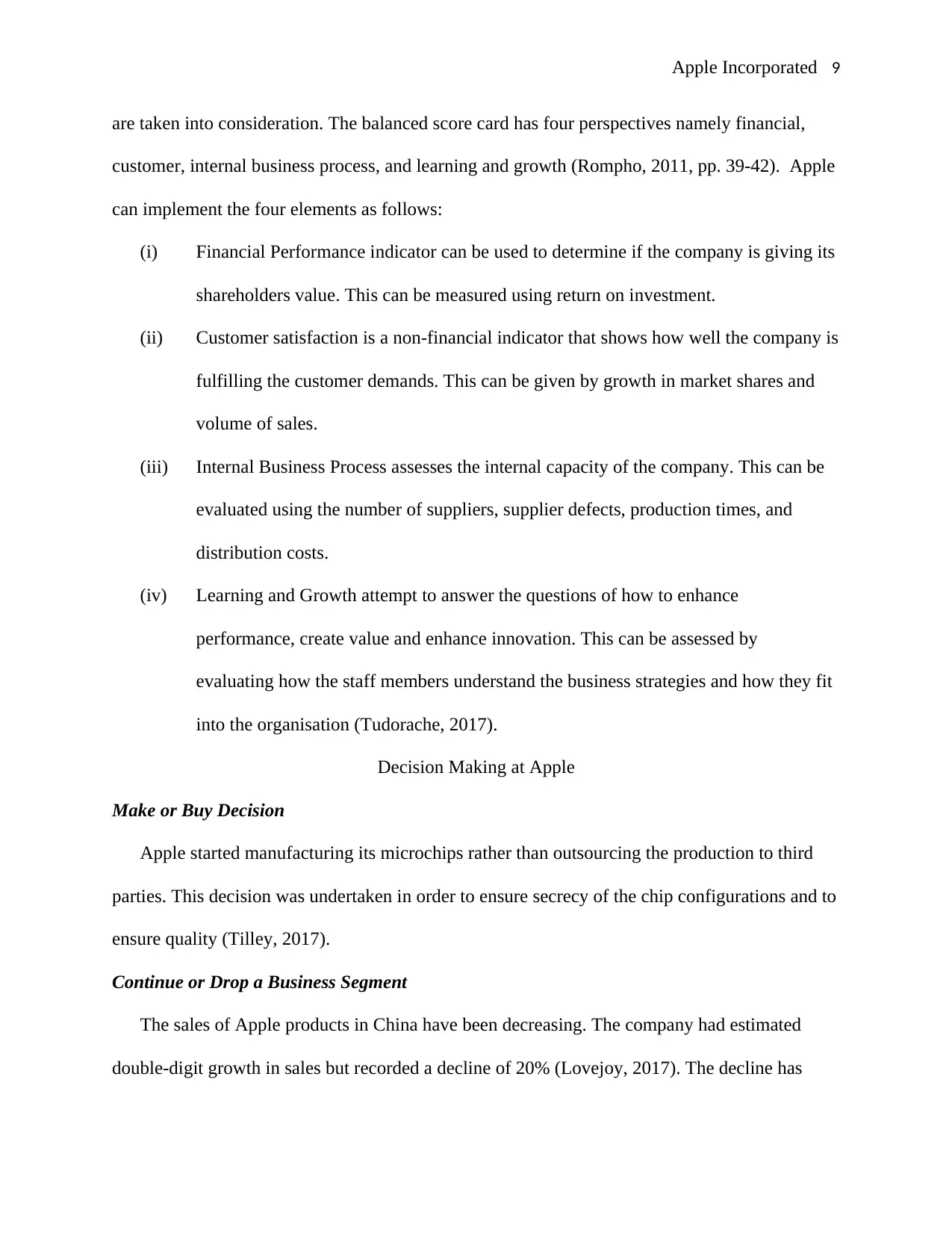
Apple Incorporated 9
are taken into consideration. The balanced score card has four perspectives namely financial,
customer, internal business process, and learning and growth (Rompho, 2011, pp. 39-42). Apple
can implement the four elements as follows:
(i) Financial Performance indicator can be used to determine if the company is giving its
shareholders value. This can be measured using return on investment.
(ii) Customer satisfaction is a non-financial indicator that shows how well the company is
fulfilling the customer demands. This can be given by growth in market shares and
volume of sales.
(iii) Internal Business Process assesses the internal capacity of the company. This can be
evaluated using the number of suppliers, supplier defects, production times, and
distribution costs.
(iv) Learning and Growth attempt to answer the questions of how to enhance
performance, create value and enhance innovation. This can be assessed by
evaluating how the staff members understand the business strategies and how they fit
into the organisation (Tudorache, 2017).
Decision Making at Apple
Make or Buy Decision
Apple started manufacturing its microchips rather than outsourcing the production to third
parties. This decision was undertaken in order to ensure secrecy of the chip configurations and to
ensure quality (Tilley, 2017).
Continue or Drop a Business Segment
The sales of Apple products in China have been decreasing. The company had estimated
double-digit growth in sales but recorded a decline of 20% (Lovejoy, 2017). The decline has
are taken into consideration. The balanced score card has four perspectives namely financial,
customer, internal business process, and learning and growth (Rompho, 2011, pp. 39-42). Apple
can implement the four elements as follows:
(i) Financial Performance indicator can be used to determine if the company is giving its
shareholders value. This can be measured using return on investment.
(ii) Customer satisfaction is a non-financial indicator that shows how well the company is
fulfilling the customer demands. This can be given by growth in market shares and
volume of sales.
(iii) Internal Business Process assesses the internal capacity of the company. This can be
evaluated using the number of suppliers, supplier defects, production times, and
distribution costs.
(iv) Learning and Growth attempt to answer the questions of how to enhance
performance, create value and enhance innovation. This can be assessed by
evaluating how the staff members understand the business strategies and how they fit
into the organisation (Tudorache, 2017).
Decision Making at Apple
Make or Buy Decision
Apple started manufacturing its microchips rather than outsourcing the production to third
parties. This decision was undertaken in order to ensure secrecy of the chip configurations and to
ensure quality (Tilley, 2017).
Continue or Drop a Business Segment
The sales of Apple products in China have been decreasing. The company had estimated
double-digit growth in sales but recorded a decline of 20% (Lovejoy, 2017). The decline has
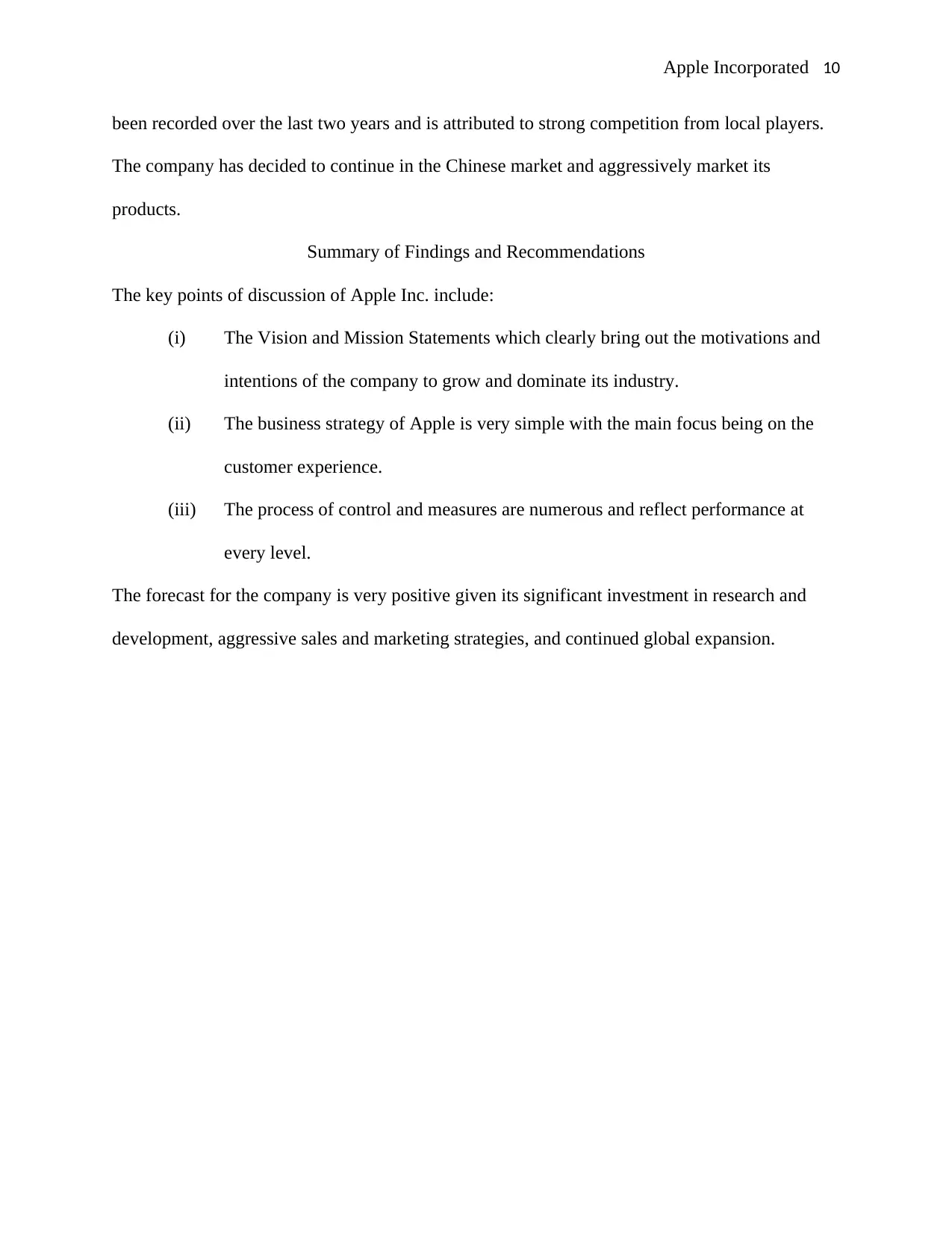
Apple Incorporated 10
been recorded over the last two years and is attributed to strong competition from local players.
The company has decided to continue in the Chinese market and aggressively market its
products.
Summary of Findings and Recommendations
The key points of discussion of Apple Inc. include:
(i) The Vision and Mission Statements which clearly bring out the motivations and
intentions of the company to grow and dominate its industry.
(ii) The business strategy of Apple is very simple with the main focus being on the
customer experience.
(iii) The process of control and measures are numerous and reflect performance at
every level.
The forecast for the company is very positive given its significant investment in research and
development, aggressive sales and marketing strategies, and continued global expansion.
been recorded over the last two years and is attributed to strong competition from local players.
The company has decided to continue in the Chinese market and aggressively market its
products.
Summary of Findings and Recommendations
The key points of discussion of Apple Inc. include:
(i) The Vision and Mission Statements which clearly bring out the motivations and
intentions of the company to grow and dominate its industry.
(ii) The business strategy of Apple is very simple with the main focus being on the
customer experience.
(iii) The process of control and measures are numerous and reflect performance at
every level.
The forecast for the company is very positive given its significant investment in research and
development, aggressive sales and marketing strategies, and continued global expansion.
Secure Best Marks with AI Grader
Need help grading? Try our AI Grader for instant feedback on your assignments.
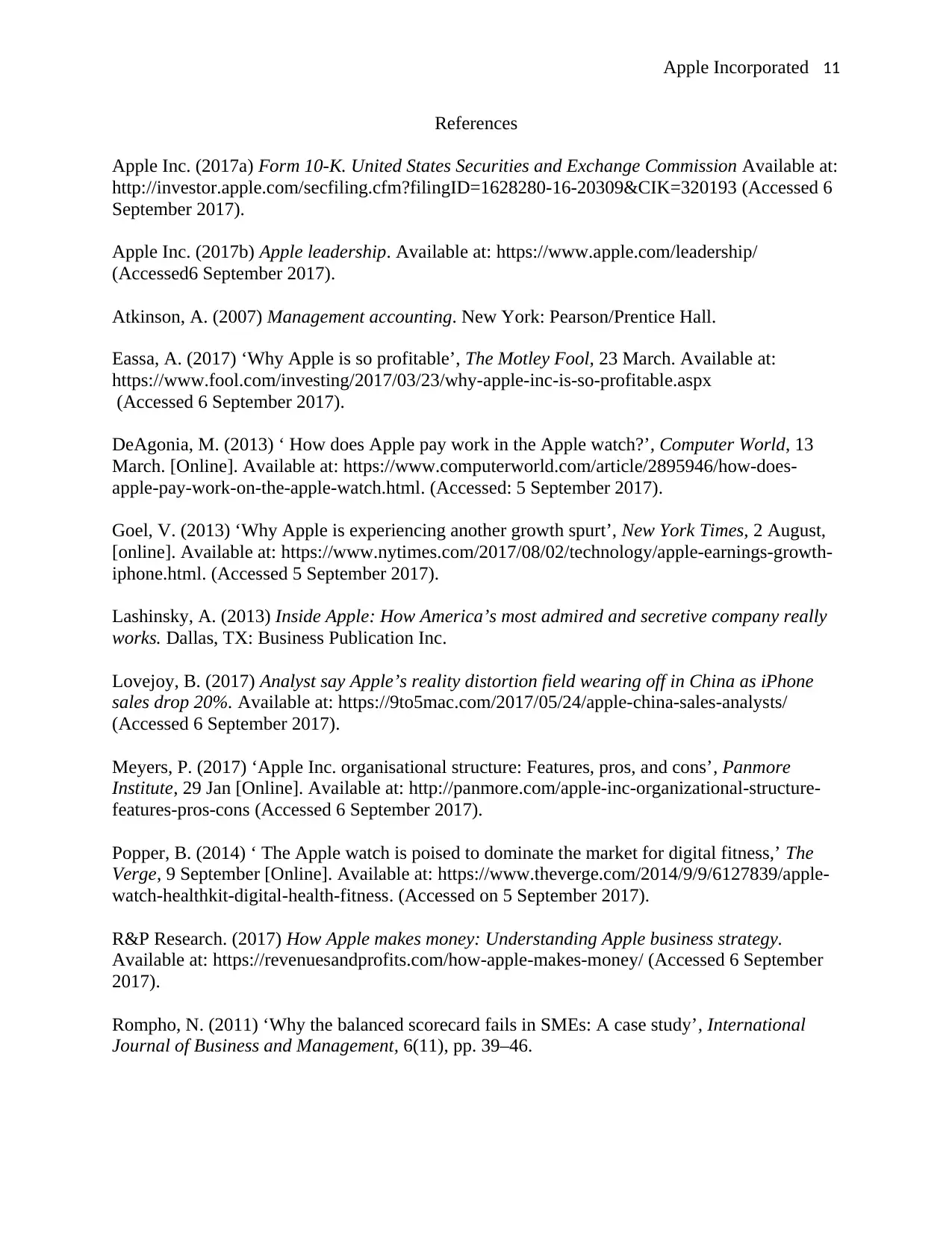
Apple Incorporated 11
References
Apple Inc. (2017a) Form 10-K. United States Securities and Exchange Commission Available at:
http://investor.apple.com/secfiling.cfm?filingID=1628280-16-20309&CIK=320193 (Accessed 6
September 2017).
Apple Inc. (2017b) Apple leadership. Available at: https://www.apple.com/leadership/
(Accessed6 September 2017).
Atkinson, A. (2007) Management accounting. New York: Pearson/Prentice Hall.
Eassa, A. (2017) ‘Why Apple is so profitable’, The Motley Fool, 23 March. Available at:
https://www.fool.com/investing/2017/03/23/why-apple-inc-is-so-profitable.aspx
(Accessed 6 September 2017).
DeAgonia, M. (2013) ‘ How does Apple pay work in the Apple watch?’, Computer World, 13
March. [Online]. Available at: https://www.computerworld.com/article/2895946/how-does-
apple-pay-work-on-the-apple-watch.html. (Accessed: 5 September 2017).
Goel, V. (2013) ‘Why Apple is experiencing another growth spurt’, New York Times, 2 August,
[online]. Available at: https://www.nytimes.com/2017/08/02/technology/apple-earnings-growth-
iphone.html. (Accessed 5 September 2017).
Lashinsky, A. (2013) Inside Apple: How America’s most admired and secretive company really
works. Dallas, TX: Business Publication Inc.
Lovejoy, B. (2017) Analyst say Apple’s reality distortion field wearing off in China as iPhone
sales drop 20%. Available at: https://9to5mac.com/2017/05/24/apple-china-sales-analysts/
(Accessed 6 September 2017).
Meyers, P. (2017) ‘Apple Inc. organisational structure: Features, pros, and cons’, Panmore
Institute, 29 Jan [Online]. Available at: http://panmore.com/apple-inc-organizational-structure-
features-pros-cons (Accessed 6 September 2017).
Popper, B. (2014) ‘ The Apple watch is poised to dominate the market for digital fitness,’ The
Verge, 9 September [Online]. Available at: https://www.theverge.com/2014/9/9/6127839/apple-
watch-healthkit-digital-health-fitness. (Accessed on 5 September 2017).
R&P Research. (2017) How Apple makes money: Understanding Apple business strategy.
Available at: https://revenuesandprofits.com/how-apple-makes-money/ (Accessed 6 September
2017).
Rompho, N. (2011) ‘Why the balanced scorecard fails in SMEs: A case study’, International
Journal of Business and Management, 6(11), pp. 39–46.
References
Apple Inc. (2017a) Form 10-K. United States Securities and Exchange Commission Available at:
http://investor.apple.com/secfiling.cfm?filingID=1628280-16-20309&CIK=320193 (Accessed 6
September 2017).
Apple Inc. (2017b) Apple leadership. Available at: https://www.apple.com/leadership/
(Accessed6 September 2017).
Atkinson, A. (2007) Management accounting. New York: Pearson/Prentice Hall.
Eassa, A. (2017) ‘Why Apple is so profitable’, The Motley Fool, 23 March. Available at:
https://www.fool.com/investing/2017/03/23/why-apple-inc-is-so-profitable.aspx
(Accessed 6 September 2017).
DeAgonia, M. (2013) ‘ How does Apple pay work in the Apple watch?’, Computer World, 13
March. [Online]. Available at: https://www.computerworld.com/article/2895946/how-does-
apple-pay-work-on-the-apple-watch.html. (Accessed: 5 September 2017).
Goel, V. (2013) ‘Why Apple is experiencing another growth spurt’, New York Times, 2 August,
[online]. Available at: https://www.nytimes.com/2017/08/02/technology/apple-earnings-growth-
iphone.html. (Accessed 5 September 2017).
Lashinsky, A. (2013) Inside Apple: How America’s most admired and secretive company really
works. Dallas, TX: Business Publication Inc.
Lovejoy, B. (2017) Analyst say Apple’s reality distortion field wearing off in China as iPhone
sales drop 20%. Available at: https://9to5mac.com/2017/05/24/apple-china-sales-analysts/
(Accessed 6 September 2017).
Meyers, P. (2017) ‘Apple Inc. organisational structure: Features, pros, and cons’, Panmore
Institute, 29 Jan [Online]. Available at: http://panmore.com/apple-inc-organizational-structure-
features-pros-cons (Accessed 6 September 2017).
Popper, B. (2014) ‘ The Apple watch is poised to dominate the market for digital fitness,’ The
Verge, 9 September [Online]. Available at: https://www.theverge.com/2014/9/9/6127839/apple-
watch-healthkit-digital-health-fitness. (Accessed on 5 September 2017).
R&P Research. (2017) How Apple makes money: Understanding Apple business strategy.
Available at: https://revenuesandprofits.com/how-apple-makes-money/ (Accessed 6 September
2017).
Rompho, N. (2011) ‘Why the balanced scorecard fails in SMEs: A case study’, International
Journal of Business and Management, 6(11), pp. 39–46.
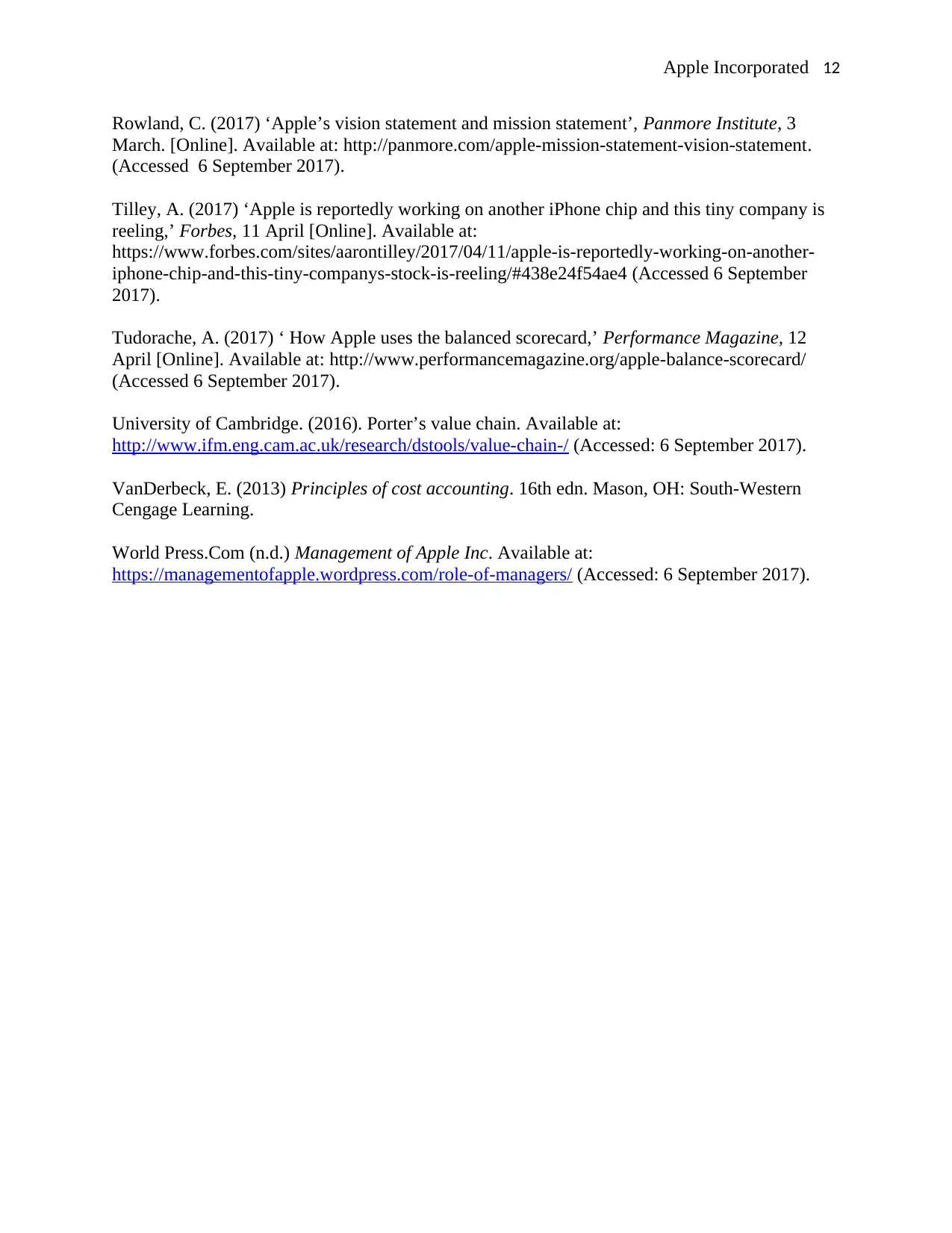
Apple Incorporated 12
Rowland, C. (2017) ‘Apple’s vision statement and mission statement’, Panmore Institute, 3
March. [Online]. Available at: http://panmore.com/apple-mission-statement-vision-statement.
(Accessed 6 September 2017).
Tilley, A. (2017) ‘Apple is reportedly working on another iPhone chip and this tiny company is
reeling,’ Forbes, 11 April [Online]. Available at:
https://www.forbes.com/sites/aarontilley/2017/04/11/apple-is-reportedly-working-on-another-
iphone-chip-and-this-tiny-companys-stock-is-reeling/#438e24f54ae4 (Accessed 6 September
2017).
Tudorache, A. (2017) ‘ How Apple uses the balanced scorecard,’ Performance Magazine, 12
April [Online]. Available at: http://www.performancemagazine.org/apple-balance-scorecard/
(Accessed 6 September 2017).
University of Cambridge. (2016). Porter’s value chain. Available at:
http://www.ifm.eng.cam.ac.uk/research/dstools/value-chain-/ (Accessed: 6 September 2017).
VanDerbeck, E. (2013) Principles of cost accounting. 16th edn. Mason, OH: South-Western
Cengage Learning.
World Press.Com (n.d.) Management of Apple Inc. Available at:
https://managementofapple.wordpress.com/role-of-managers/ (Accessed: 6 September 2017).
Rowland, C. (2017) ‘Apple’s vision statement and mission statement’, Panmore Institute, 3
March. [Online]. Available at: http://panmore.com/apple-mission-statement-vision-statement.
(Accessed 6 September 2017).
Tilley, A. (2017) ‘Apple is reportedly working on another iPhone chip and this tiny company is
reeling,’ Forbes, 11 April [Online]. Available at:
https://www.forbes.com/sites/aarontilley/2017/04/11/apple-is-reportedly-working-on-another-
iphone-chip-and-this-tiny-companys-stock-is-reeling/#438e24f54ae4 (Accessed 6 September
2017).
Tudorache, A. (2017) ‘ How Apple uses the balanced scorecard,’ Performance Magazine, 12
April [Online]. Available at: http://www.performancemagazine.org/apple-balance-scorecard/
(Accessed 6 September 2017).
University of Cambridge. (2016). Porter’s value chain. Available at:
http://www.ifm.eng.cam.ac.uk/research/dstools/value-chain-/ (Accessed: 6 September 2017).
VanDerbeck, E. (2013) Principles of cost accounting. 16th edn. Mason, OH: South-Western
Cengage Learning.
World Press.Com (n.d.) Management of Apple Inc. Available at:
https://managementofapple.wordpress.com/role-of-managers/ (Accessed: 6 September 2017).
1 out of 12
Related Documents
Your All-in-One AI-Powered Toolkit for Academic Success.
+13062052269
info@desklib.com
Available 24*7 on WhatsApp / Email
![[object Object]](/_next/static/media/star-bottom.7253800d.svg)
Unlock your academic potential
© 2024 | Zucol Services PVT LTD | All rights reserved.





